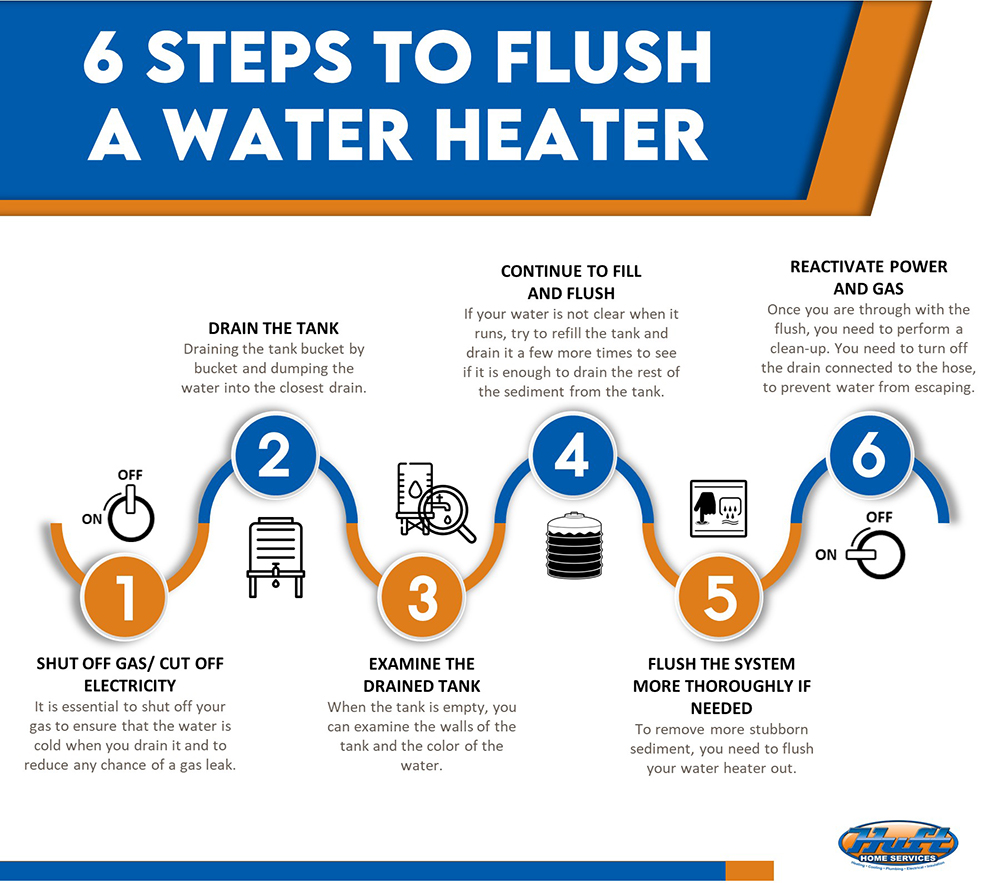Your water heater needs to work at its best capacity in order to enjoy essential hot water in your house. Flushing your water heater at least once per year helps to prevent possible sediment problems. Buildup of minerals can reduce your water heater’s heating efficiency, which may result in plumbing damage. If the sediment accumulates and calcifies, it becomes difficult to remove. Here are seven steps to effectively flush your water heater for improved heating efficiency and increased lifespan. Huft Home Services can also send a Sacramento plumber to your home to help at any time!
1. Shut off Gas/ Cut off Electricity
Finally, give the water a chance to cool down before you begin to work. This can take several hours. To speed this up, shut off the power right before a shower or bath to help use up the hot water before you begin the process. The heater will then refill but it won’t heat the water. Often, you’ll find a thermostat on the side of the heater that can tell you when the water is at a temperature that is safe and comfortable to work with. If you take these preparatory steps, you create a safe working environment for flushing your water heater.

2. Drain the Tank
The next step is to drain the tank. Most models of hot water heaters have a drain that is specifically designed for this. Many of them have a threaded tap that can be attached to a hose. This hose can be run outdoors, into a floor drain or even into a nearby sink. If none of these are close to your machine, consider draining the tank bucket by bucket and dumping the water into the closest drain. This last option will take more time but it will prevent any water damage to your floor and home.
When flushing your water heater you will need to shut off the valve supplying the cold water. Otherwise, the tank will continue to refill as you drain it.
3. Examine the Drained Tank
When the tank is empty, you can examine the walls of the tank and the color of the water. These elements can help you identify the condition of the heater. If the water is clear, it means that your heater is doing well and is in good shape.
On the other hand, if the water is darker or cloudy with sediments, it means that your water heater requires flushing. When emptying the tank and you realize there’s quite an amount of sediment or other solid materials, it means the tank requires a water heater flush for sediments.
4. Continue to Fill and Flush
If your water is not clear when it runs, try to refill the tank and drain it a few more times to see if it is enough to drain the rest of the sediment from the tank. If you have regularly flushed the system or if your water is low in sediment, this should be enough and you can skip any further steps related to flushing.
Depending on the level of sediment, you may need our professionals to assist in flushing the tank. A professional can thoroughly flush your water heater and perform a checkup to ensure that it runs effectively for a long time. Make sure you seek professional help to avoid dealing with more serious sediment issues or buildup that may hinder you from enjoying hot water in your house. This is a good time to ask a professional if they believe that any additional components like a water softener are helpful and find out the remaining lifespan of your heater. This is a great opportunity to have the time to budget for a new system before it becomes an emergency.
5. Flush the System More Thoroughly if Needed
To remove more stubborn sediment, you need to flush your water heater out. During this time, you need to turn on the cold-water spigot that was initially turned off, so that clean water can flush out the system. You may want to use a hose to help clean out any sediment at the bottom of the tank. Once the sediment is gone, take a look at the inside to check the condition.
This is a great time to spot rust or other issues before they cause your water heater to leak. One good way to look for cracks is to shine a flashlight into the tank with the lights off and look for signs that light is shining through. Typically, if the tank is corroding, you would have also seen rusty water when draining the tank. If the tank is corroding, consider replacing your water heater instead of refilling the one you have.
Take a few minutes to flush the water tank and ensure that the water is clear and normal, to indicate that the system has been effectively flushed. Before you take out the hose and/or remove the bucket, ensure that you turn off the cold water supply in order to avoid a messy finish.
6. Reactivate Power and Gas
Once you are through with the flush, you need to perform a clean-up. First, you need to turn off the drain connected to the hose, to prevent water from escaping. Be certain that any valves going into the tank are turned off and secure.
You will have to fill back your tank by turning on the cold water. When your tank is full, ensure that you open the pressure valve so that the air can escape, to ensure the unit operates optimally. Make sure that you also open the hot water faucet again, so that any excess air is not trapped in and is let out.
The final step of flushing your water heater is to re-light your gas unit or turn your electrical unit on at the breaker. Once you have done this, you will have to give the water about 30 mins before checking whether the system is heating as it should.
We Can Help With Your Plumbing and Other Home Maintenance, Installation and Repair
Most people are used to performing their household chores. The seven steps above help in flushing your water heater to ensure that it performs at its best. If you need help, our experts have seasoned experience in flushing water heaters. Give us a call at Huft Home services – we provide Sacramento water heater services. We also provide heating, plumbing, electrical and insulation services to Sacramento, El Dorado, Placer, Yuba and San Joaquin counties.



